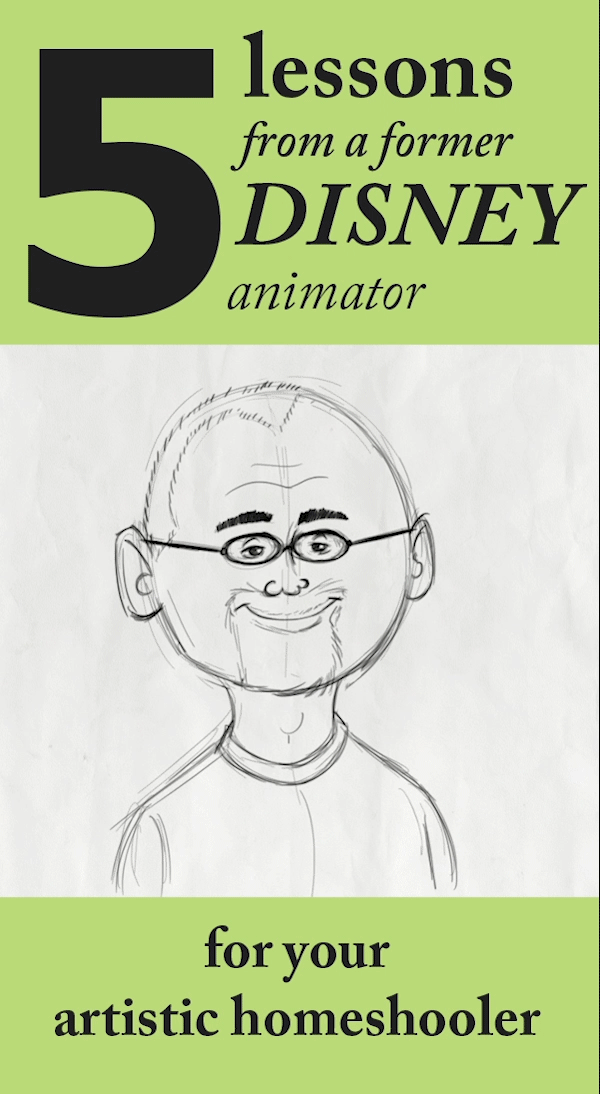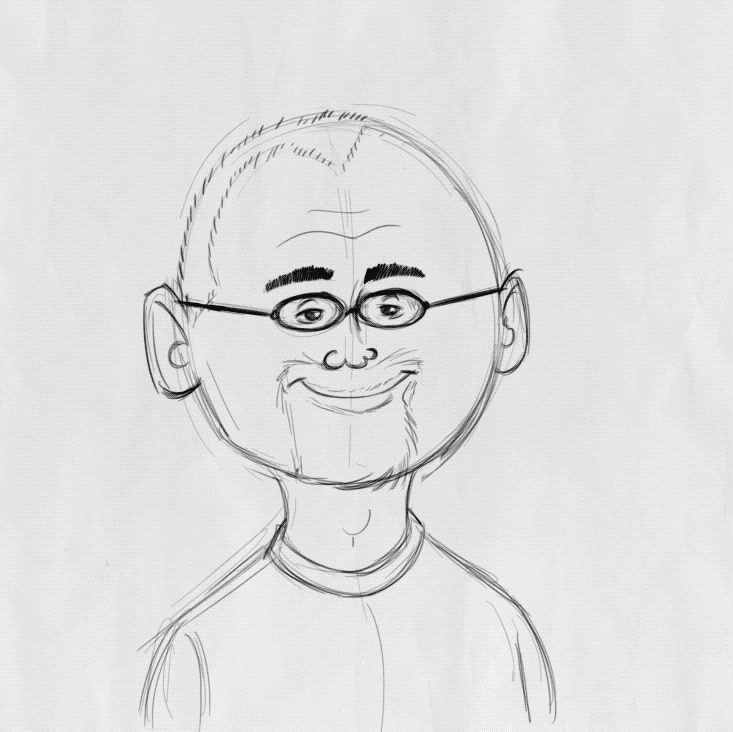Your homeschooler is beginning to show promise in an artistic endeavor like music, drawing, theater, or something else! And that’s exciting. But if you’re like most parents, it can also feel intimidating. While you know that it’s possible for your child to grow up and make money as an artist, you might not be able to get the image of the all-too-cliche starving artist out of your head.
To be honest, my parents had a similar reaction when I decided in 6th grade (in 1980!) that I was going to be an animator when I grew up. Now that I’ve been a professional animator for about 30 years (with some of those years at Disney), and have worked on 20 films, my parents and I can look back on my bigger-than-life childhood dreams with fondness, but I know they must have been pretty nervous every time I brought up this career they knew nothing about.
These days, I teach animation to kids who are just like I was, dreaming big and hungry for a career as an artist. And I’m going to be honest, getting to where I am today wasn’t easy, so when they ask me what they can do in order to turn that dream into their reality, these are some of the things I share with them.
Get Really Good at Your Craft
When I was finally “successful” enough to get a lawyer who would help me negotiate salaries and navigate the film industry, she told me something that has stuck with me ever since: “I cannot get you more money unless they really like your work.” Essentially, she was clarifying with me that at the end of the day, it was on me to be a good animator if I wanted a job, she couldn’t simply hack the system for me.
If you want to “make it” in the film industry, or the music industry, or any industry, there’s no way around it -- you’re simply going to have to be good at what you do. Unfortunately, there’s no way to hack the system or cut corners if you want to be successful, so practice. Practice a lot.
Embrace Critique
One of the things I struggled with while I was at Disney was critique of my work. I was just too insecure about my animation. Whenever someone asked for a change, I took that as judgement and condemnation of my artistic ability. And I had my identity so tied up in my artwork and animation, that it also felt like I was being judged and condemned as a person. Needless to say, I fought back a little too much. When I moved over to Sony Pictures, I decided that whatever a supervisor asked for, I would just give my best attempt, with no argument. And lo and behold, I started learning things. Lots of things and my animation got a lot better!
If you’re going to become really good at your craft, there’s simply no way to do that without embracing critique. Critique can be one of the hardest things to face as an artist, especially since you likely poured your heart and soul into your work. However, it is impossible to improve without accepting what it is that you need to improve, so swallow your pride, and accept criticism from everyone.
Yes, I mean everyone, even people you wouldn’t consider experts. Art is a vessel for communicating an idea, so if the average person doesn’t understand what you’re attempting to communicate, then your art hasn’t been effective. Now, if you’d rather just create things for fun and don’t really care if it turns into your career or not, then no need to listen to anyone’s criticism (although you’ll be stuck in one single perspective - your own). If, on the other hand, your desire is for others to consume and enjoy your art, you’ll need to listen to the feedback of others.
I get it, it’s extremely difficult to let people tell you what they honestly think about something you’ve poured so much into, but if you want to become an expert, push yourself to embrace critique.
Learn to Collaborate
When I first started on the film Cats Don’t Dance, I got some great opportunities to take on and lead a small character. I was also given some key shots for the main character, Danny. Of course, I was extremely excited so I let my success go to my head a bit. As this was my first time leading any project professionally, I thought that being a ‘great’ artist meant telling everyone else what to do, and telling them to do it my way. However, I was missing out on the great skills and experience that many of the people were working with me had! Because I was so hard to work with, the finished result might not have been as good as it could have been since I didn’t trust the team of people working with me.
If you’re going to be a professional creative, whether that’s an animator like myself, something else in the film industry, a photographer, a musician, a graphic artist, or anything else, you’ll likely be working on a team. In my experience, sometimes the most talented person can be the least fun to work with. Even if they’re extremely skilled, no one will want to work with them, because they aren’t a team player.
If you can practice collaborating, compromising, listening to, and respecting others, you’ll have a leg up on most of the creatives around you. If you’re a musician, start a band; if you’re a photographer, shoot a project with friends; if you’re a filmmaker, make a film with other filmmakers. This one simple thing differentiates those who go far in their careers and those who don’t. Learn to collaborate with others and be a team player.
Follow Directions
When I started work on my very first projects as an animator, I often didn’t follow the directions I was given by my supervisor exactly. I would vary a bit, thinking that maybe my supervisor would appreciate the awesome creativity I had to offer. However, I was working on a team of literally hundreds of other people, so to be frank, no one wanted my opinion. Dazed and confused after multiple scathing reviews of my super-awesome-stand-out sequences, I finally realized that if I didn’t follow my supervisor’s instructions, I would only get penalized.
Following someone else’s vision feels uncomfortable. It sometimes requires you to work in a different style than you’re used to, maybe even one you personally dislike, not to mention that creatives generally thrive on individuality. But if you’re going to pursue a career as a creative, you’re going to have to learn how to follow someone else’s instructions whether that’s your director, your client, or anyone else giving you a project.
Now here’s the fun part: when I finally realized that it was in my best interest to follow directions, that’s what I began to do. After a while, I noticed that my supervisors began to really trust me and they even began to ask my opinion. Delivering what your supervisor, director, or client asks for in the first place is the surest way to be able to flex that creative muscle and get your original ideas in the final project.
Put yourself out there
During my initial time at Disney, I learned that each film operated kind of like its own company. The directors and many of the lead artists were different from film to film. Even if you connected and made relationships with one set of people on one film, you might find yourself out of a job if you didn’t put yourself out there and meet the “Big Cheeses” on the next film. This was very difficult for me! I was much happier just sitting and drawing at my desk than making the “cold call” or putting myself out there. I knew that I had to do it, though, so while I was working on Tarzan, I looked up the phone number for a director that I greatly admired and was developing a film. As I called him, I was shaking in my boots, but he graciously set up some time with me to see my work. And he liked it! That led to a small role on his film in Fantasia, which kept me going until The Emperor’s New Groove. I took that small lesson and applied it to a grander scale when I launched into the world of freelance. I was going to have to meet, mingle and repeat. Of course, not every opportunity panned out, but enough did that I was able to succeed.
We’ve all been there - you finish creating something only to feel like you’re coming up for air after pouring literally everything you have into your craft. Because it takes so much creative energy to make something, it’s extremely easy to hold your art close and never share it with the world. However, that defeats the purpose of your art and denies you any sort of successful career!
If you want to start making any money from your art, you need to put yourself out there. Try these things to get outside your comfort zone and practice sharing your craft:
Post it online and share it with your friends (I know, terrifying). However, if you’re confident, you’ll be surprised at how many people will take you seriously and think that what you’re doing is really awesome!
Call someone you respect and ask if you can show them your art and get their opinion. It’s incredibly beneficial to have people more experienced than you giving you feedback.
This one is the easiest, and yet can be so hard: when others inevitably ask to see your art, maybe at a family gathering or party with friends, show them. When someone is asking to see what you’ve created, they already want you to share it with them, so take advantage of the opportunity, and share your art with others.
These are just a few things that I’ve learned over my 30 year career as a creative. I have worked as a professional animator in film and television for almost 30 years both with Walt Disney Feature Animation and Sony Pictures on films like Emperor's New Groove, Tarzan, and Polar Express. Now I’m bringing my wide experience—both from the professional animation field and from being an expert homeschooling dad—into teaching students ages 11-18 about this fascinating art form. If your child is interested in animation, filmmaking, or storytelling, check out The Animation Course!
Chad Stewart
Founder & Teacher, The Animation Course
Former Disney Animator



